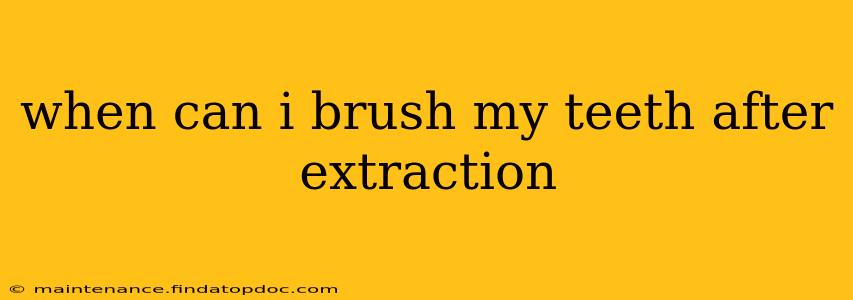Tooth extraction, while a common procedure, leaves your mouth vulnerable. Knowing when and how to brush your teeth afterward is crucial for preventing infection and promoting proper healing. This comprehensive guide will answer all your questions about oral hygiene post-extraction.
What Happens Immediately After a Tooth Extraction?
Following a tooth extraction, your dentist will place a gauze pad over the extraction site to control bleeding. This typically needs to remain in place for about 30-45 minutes, or until bleeding significantly subsides. During this time, it's crucial to avoid disturbing the clot forming in the socket. This blood clot is essential for healing and preventing a painful and potentially serious complication known as dry socket.
How Long Should I Wait Before Brushing My Teeth?
This is the most common question after an extraction, and the answer is nuanced. Generally, it's best to wait at least 24 hours before brushing your teeth near the extraction site. This allows the blood clot to form properly and minimizes the risk of dislodging it. However, gentle brushing of other teeth is usually permissible, as long as you avoid the extraction site.
Can I Rinse My Mouth After a Tooth Extraction?
Gentle rinsing is often recommended, but again, wait at least 24 hours before doing so near the extraction site. Avoid forceful rinsing or spitting, as this can dislodge the blood clot. Your dentist might recommend a saltwater rinse (a teaspoon of salt dissolved in a glass of warm water) to help keep the area clean and reduce swelling. This should be done gently and sparingly.
What About Flossing After Extraction?
Similar to brushing, avoid flossing near the extraction site for at least 24 hours, and potentially longer depending on your dentist's instructions. Flossing can disturb the healing process and increase the risk of complications.
What if I Get Food Stuck Near the Extraction Site?
It's common to get some food particles near the extraction site, especially in the first few days. If this happens, try gently rinsing with warm salt water. Avoid probing or picking at the area with anything that could dislodge the clot.
When Can I Resume My Normal Oral Hygiene Routine?
After the initial 24-hour period (or as directed by your dentist), you can gradually resume your normal brushing and flossing routine. However, be very gentle when brushing near the extraction site for several days. Use a soft-bristled toothbrush and avoid brushing directly on the socket.
What are the Signs of Complications After a Tooth Extraction?
It's important to monitor the extraction site for any signs of complications. Contact your dentist immediately if you experience:
- Excessive bleeding: Bleeding that continues for hours or soaks through multiple gauze pads.
- Severe pain or throbbing: Pain that doesn't respond to over-the-counter pain relievers.
- Dry socket: Severe pain, a bad taste in your mouth, and a visible empty socket.
- Signs of infection: Increased swelling, redness, pus, or fever.
Can I Brush My Teeth if I Have Stitches?
If you have stitches, it's especially crucial to be gentle when brushing your teeth near the extraction site. Avoid brushing directly over the stitches until they are removed by your dentist.
Following your dentist's specific post-operative instructions is key to a smooth recovery after a tooth extraction. Remember, patience and gentle care are crucial to ensuring proper healing and minimizing any complications. Always reach out to your dentist with any concerns or questions you may have.
